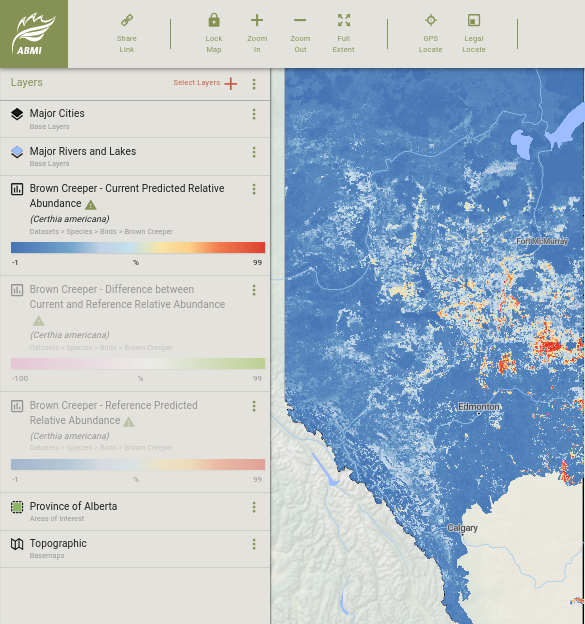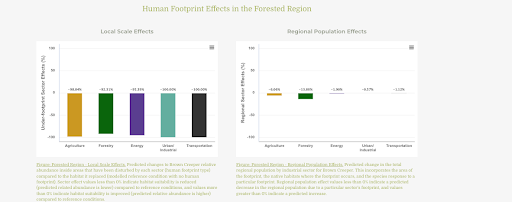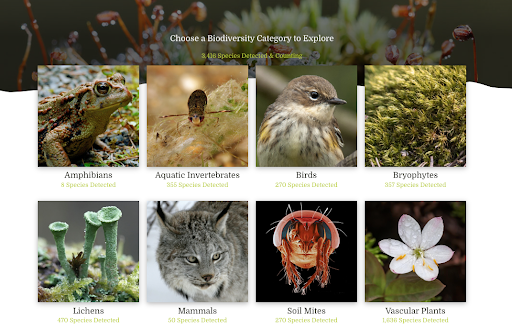The ABMI is pleased to announce that the Biodiversity Browser (BB) has been updated with new species modelling, new mammal sections, and an updated design to optimize navigation. So, let’s delve a little deeper into what you can find and do on the portal.
The ABMI’s Biodiversity Browser is a versatile repository full of freely available data on Alberta’s wildlife and habitats. The browser also features species profiles of birds, mammals, amphibians, soil mites, vascular plants, lichens, and mosses found in Alberta. These data are a culmination of many years’ (often over 20 years’ of data) of on-the-ground species monitoring across Alberta together with rigorous scientific analysis by the ABMI. We would like to acknowledge that the research and data presented in this site is only possible thanks to collaborations with our delivery partners and financial support from our sponsors.*

Boreal Oakmoss (Everna mesomorpha)
In addition to a plethora of interesting facts (did you know that the Canada Lynx (Lynx canadensis) can spot its prey almost a football field away?) and beautiful photos (see Boreal Oakmoss Lichen (Everna mesomorpha) that can serve classrooms and educational projects, the Biodiversity Browser provides data and maps on habitat suitability, habitat associations, effects of human footprint, and data specific to the Oil Sands Region.
Spotlight on the Brown Creeper in the Biodiversity Browser

Let’s take a look at the fluffy-looking Brown Creeper (Certhia americana), a species designated as Sensitive and found mainly in the forested region of Alberta. On the Biodiversity Browser we can view maps of its habitat suitability (along with an interpretation guide) linked to our mapping portal. In the habitat associations graphs we can see that this bird prefers old forest (see the area coloured in red in the map) and that there are few detections in Alberta’s prairie region (area coloured in white).

Current condition map shows habitat suitability under current human footprint.
In the Biodiversity Browser’s human footprint section we learn that the Brown Creeper requires large, mature trees for feeding and large standing dead trees (also known as snags) for nesting. Therefore, it is negatively affected by forestry practices that reduce large stem density, and by salvage logging of dead trees.

Occurrence map
We can view the Brown Creeper’s occurrence in the Oil Sands Region as well, again linking to the ABMI’s mapping portal.
Recent BB Updates: Species Modelling, New Mammal Sections and New Design
Our recent updates to the Biodiversity Browser provide even more opportunities to find useful data and interact with information on over 3,000 species and multiple species groups as well.
- Updated species modelling results incorporate our latest field data.
- A new section for six mammal species (Black Bear, Canada Lynx, Coyote, Moose, Snowshoe Hare, White-tailed Deer), summarizes preliminary monitoring results in the Oil Sands Region. Results show how the abundances of these species are predicted to change in response to energy-related human footprint.
- Updates to the design of the species profiles make it easier to navigate between the sections: Status in Alberta, OSR Monitoring Results, and Species Facts.
Take a look, and see what is happening with your favourite Alberta species!
*We are grateful for the support of the ABMI’s delivery partners: Innotech Alberta, University of Alberta, University of Calgary. We would like to acknowledge financial support from the Government of Alberta and the Oil Sands Monitoring Program.

